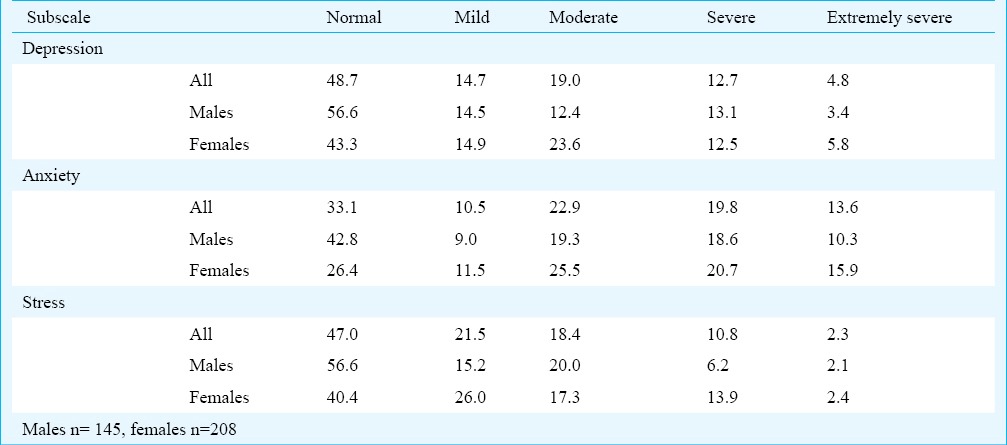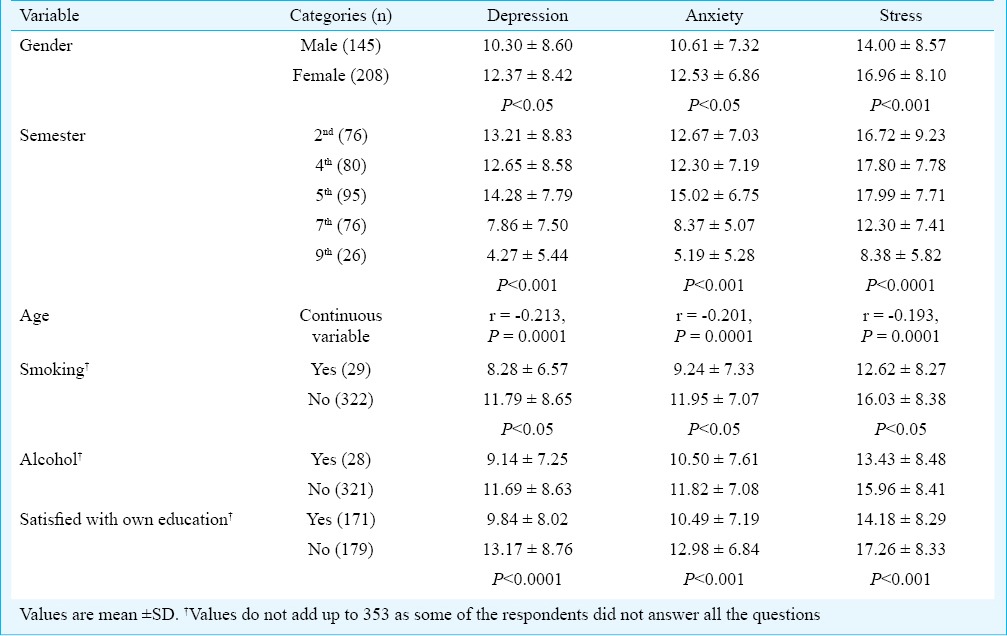Abstract
Background & objectives:
Presence of psychological morbidity in medical undergraduate students has been reported from various countries across the world. Indian studies to document this burden are very few. Therefore, the presence of depression, anxiety and stress among medical undergraduate students was assessed using a previously validated and standardized instrument, Depression Anxiety Stress Scale (DASS 42) and the associations with their socio-demographic and personal characteristics were identified.
Methods:
In a cross-sectional survey, a self-administered, pre-designed, pre-tested anonymous questionnaire including DASS 42 was used to collect information on basic socio-demographic (age, gender, semester) and personal characteristics (alcohol and tobacco use, academic performance). All students present on the day of survey were contacted for participation after obtaining informed written consent. Scores for each of the respondents over each of the sub-scales (Depression, Anxiety and Stress) were calculated as per the severity-rating index.
Results:
More than half of the respondents were affected by depression (51.3%), anxiety (66.9%) and stress (53%). Morbidity was found to be more in 5th semester students rather than students of 2nd semester. Females reported higher score as compared to their male counterparts. Perception of self assessment in academics was strongly associated with the higher score.
Conclusions:
A substantial proportion of medical undergraduate students was found to be depressed, anxious and stressed revealing a neglected area of the students’ psychology requiring urgent attention. Student counselling services need to be made available and accessible to curb this morbidity.
Keywords: Anxiety, DASS 42, depression, medical students, stress
Medical education can impose significant psychological stress on undergraduates1. Considerable degree of psychological morbidity has been reported among medical students ranging from stress, interpersonal problems and suicidal ideation to psychiatric disorders2,3,4,5,6,7 and they tend to have greater psychological distress than the general population5. We undertook this study to determine the presence of depression, anxiety and stress among medical undergraduates studying in a premier medical institution in Odisha (eastern India) and their socio-demographic correlates were also assessed.
Material & Methods
This study was conducted in the Institute of Medical Sciences at Bhubaneswar, Odisha, India, during July-August 2012. Students (both male and female) enrolled for at least six months prior to study and were present on the day of the survey were requested for participation. The study protocol was approved by the institutional ethical committee.
In this corss-sectional survey, a self-administered, pre-designed, pre-tested anonymous questionnaire (in English language) was distributed after obtaining an informed written consent from each participant. Information was collected on basic socio-demographic (like age, gender and semester) and personal characteristics (like alcohol and tobacco use, academic performance). A previously validated and standardized survey instrument, Depression Anxiety Stress Scale (DASS 42)8 was used to assess information on depression, anxiety and stress.
The data were analyzed with SPSS v20.0 software (IBM Corp., Armonk, NY). Continuous data were expressed in terms of mean and standard deviation (SD). Means were compared using Student t test and ANOVA. Correlations between continuous variables were calculated using Pearson's correlation test. Multivariable step-wise linear regression analysis was carried out to find the role of each significant variable in determining the relevant sub-scale scores.
Results & Discussion
Among the 353 respondents, 145 (41.1%) were males. The mean age of males was 21.38 ± 1.71 yr and that of females was 20.43 ± 1.37 yr. The mean non-response rate to questions of DASS scale was 3.26 ± 2.1 per cent (range = 0.28 to 8.28%). Based on score ranges from the DASS manual, 62 (17.5%) students had severe or extremely severe depression. This percentage was 33.4 per cent for anxiety and 13.1 per cent for stress. The mean scores of depression and stress for all students were found to be at mild level and the scores of anxiety at moderate level (Table I).
Table I.
Severity distribution of DASS scores (%) among medical undergraduate students (n=353)

Univariate analysis (Table II) showed that higher scores of depression, anxiety and stress was associated with female gender, lower semester, younger age and non smokers, Students who were satisfied with their education had lower depression, anxiety and stress scores. Though the scores were higher among non-alcoholics the difference was not significant.
Table II.
Univariate analysis of association of DASS scores with socio-demographic and personal characteristics among medical undergraduate students

Multivariable linear regression showed (Table III) that semester was a significant predictor of all the three subscales and gender predicted only the stress sub-scale. The variables, which were used in regression, explained only 7.7 per cent of depression, 7.9 per cent of anxiety and 9.1 per cent of stress.
Table III.
Multivariable linear regression analysis of association of DASS scores with socio-demographic and personal characteristics among medical undergraduate students

Medical school training is intended to prepare graduates for a personally rewarding and socially meaningful career. However, reports have shown that this is a time of great personal distress for physicians-in-training5. It has long been recognized as involving numerous stressors that can affect the wellbeing of the students9. Our study also showed that there was a considerable level of depression, anxiety and stress in our setting revealing a neglected area of the students’ psychology requiring urgent attention. Our sample of students had higher mean depression, anxiety and stress scores compared with previously published data10 using DASS subscales.
Fifth semester students had highest depression, anxiety and stress scores as compared to others. Similar findings have been reported earlier11,12,13. This may be attributed to greater fear of not attaining their goal of being a doctor or may be due to excessive load of both paraclinical and clinical subjects as compared to only clinical subjects in the latter years.
Consistent with other studies12,13 female respondents had reported higher scores of depression, anxiety and stress compared with their male counterparts. This may be due to the fact that women articulate depressive symptoms, even minor ones, more easily14. However, regression analysis showed significant association only in case of stress scores. Contrary to earlier findings15, the association of abuse of alcohol or the habit of smoking was not associated with any of the morbidity, which could be due to small number of respondents.
Student distress may influence professional development and adversely impact academic performance contributing to academic dishonesty and substance abuse, and may play a role in attrition from medical school5. Other studies on medical school graduates also suggest that distress may negatively affect quality of patient care, patient safety15, and professionalism16.
In conclusion, more than half of the medical undergraduate students were found to be affected by depression, anxiety and stress. There is a need for the counselling services to be made available to the students in the medical college to control this morbidity.
References
- 1.Mosley TH, Jr, Perrin SG, Neral SM, Dubbert PM, Grothues CA, Pinto BM. Stress, coping, and well-being among third year medical students. Acad Med. 1994;69:765–7. doi: 10.1097/00001888-199409000-00024. [DOI] [PubMed] [Google Scholar]
- 2.Aktekin M, Karaman T, Senol YY, Erdem S, Erengin H, Akaydin M. Anxiety, depression and stressful life events among medical students: a prospective study in Antalya, Turkey. Med Educ. 2001;35:12–7. doi: 10.1046/j.1365-2923.2001.00726.x. [DOI] [PubMed] [Google Scholar]
- 3.Chandavarkar U, Azam A, Mathews CA. Anxiety symptoms and perceived performance in medical students. Depress Anxiety. 2007;24:103–11. doi: 10.1002/da.20185. [DOI] [PubMed] [Google Scholar]
- 4.Eller T, Aluoja A, Vasar V, Veldi M. Symptoms of anxiety and depression in Estonian medical students with sleep problems. Depress Anxiety. 2006;23:250–6. doi: 10.1002/da.20166. [DOI] [PubMed] [Google Scholar]
- 5.Dyrbye LN, Thomas MR, Shanafelt TD, Sreeramareddy CT. Perceived stress, sources and severity of stress among medical undergraduates in a Pakistani Medical School. BMC Med Educ. 2006;81:354–73. doi: 10.1186/1472-6920-10-2. [DOI] [PMC free article] [PubMed] [Google Scholar]
- 6.Shah M, Hassan S, Malik S, Sreeramareddy CT. Perceived stress, sources and severity of stress among medical undergraduates in a Pakistani Medical School. BMC Med Educ. 2010;10:2. doi: 10.1186/1472-6920-10-2. [DOI] [PMC free article] [PubMed] [Google Scholar]
- 7.Bayram N, Bilgel N. The prevalence and socio-demographic correlations of depression, anxiety and stress among a group of university students. Soc Psychiatry Psychiatr Epidemiol. 2008;43:667–72. doi: 10.1007/s00127-008-0345-x. [DOI] [PubMed] [Google Scholar]
- 8.Crawford JR, Henry JD. The Depression Anxiety Stress Scales (DASS): Normative data and latent structure in a large non-clinical sample. Br J Clin Psychol. 2003;42:111–31. doi: 10.1348/014466503321903544. [DOI] [PubMed] [Google Scholar]
- 9.Khan MS, Mahmood S, Badshah A, Ali SU, Jamal Y. Prevalence of depression, anxiety and their associated factors among medical students in Karachi, Pakistan. J Pak Med Assoc. 2006;56:583–6. [PubMed] [Google Scholar]
- 10.Bayram N, Bilgel N. The prevalence and socio-demographic correlations of depression, anxiety and stress among a group of university students. Soc Psychiatry Psychiatr Epidemiol. 2008;43:667–72. doi: 10.1007/s00127-008-0345-x. [DOI] [PubMed] [Google Scholar]
- 11.Kumarswamy N, Ebigbo PO. Stress among second year medical students - A comparative study. Indian J Clin Psychol. 1989;16:21–3. [Google Scholar]
- 12.Singh A, Lal A, Shekhar Prevalence of depression among medical students of a private medical college in India. Online J Health Allied Sci. 2010;9:8. [Google Scholar]
- 13.Supe AN. A study of stress in medical students at Seth G.S. Medical College. J Postgrad Med. 1998;44:1–6. [PubMed] [Google Scholar]
- 14.Noble RE. Depression in women. Metabolism. 2005;54:49–52. doi: 10.1016/j.metabol.2005.01.014. [DOI] [PubMed] [Google Scholar]
- 15.Shanafelt TD, Bradley KA, Wipf JE, Back AL. Burnout and self-reported patient care in an internal medicine residency program. Ann Intern Med. 2002;136:358–67. doi: 10.7326/0003-4819-136-5-200203050-00008. [DOI] [PubMed] [Google Scholar]
- 16.Mareiniss DP. Decreasing GME training stress to foster residents’ professionalism. Acad Med. 2004;79:825–31. doi: 10.1097/00001888-200409000-00003. [DOI] [PubMed] [Google Scholar]


